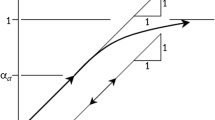Abstract
A constitutive model of concrete subjected to elevated temperature is suggested in this study. The model is composed of four strain components: free thermal strain, mechanical strain, thermal creep strain, and transient strain due to moisture. The thermal creep strain of concrete is derived from the modified power-law relation for steady state creep. Mathematical description on the multi-axial creep behavior of concrete is also presented. The transient strain component is made in order to consider rapid irreversible strain change of moisture diffusion and evaporation. Some applications for the proposed model are carried out by a nonlinear analysis and compared with the test results. The comparisons with the test results show that the proposed model gives a good agreement and the influences of inelastic strain changes at elevated temperatures are very important for the structural response at elevated temperatures.
Similar content being viewed by others
References
American Concrete Institute, Guide for Determining the Fire Endurance of Concrete Elements, ACI 216R-89, 1989.
American Society of Civil Engineers, “Structural Fire Protection, A,” in ASCE Manuals and Reports on Engineering Practice No. 78, 1992.
ASTM Standards, “Standard Test Methods for Fire Tests of Building Construction and Materials,” in Annual Book of ASTM Standards, Vol. 04, Designation: E 119–88, ASTM, 1988, pp. 922–942.
W.P.S. Dias, G.A. Khoury, and P.J.E. Sullivan, “Basic Creep of Unsealed Hardened Cement Paste at Temperatures between 20°C and 725°C,” Magazine of Concrete Research, Vol. 39,No. 139, 1989, pp. 93–101.
W.P.S. Dias, G.A. Khoury, and P.J.E. Sullivan, “An Activation Energy Approach for the Temperature Dependence of Basic Creep of Hardened Cement Paste,” Magazine of Concrete Research, Vol. 39,No. 140, 1987, pp. 141–147.
W.P.S. Dias, G.A. Khoury, and P.J.E. Sullivan, “The Thermal and Structural Effects of Elevated Temperatures on the Basic Creep of Hardened Cement Paste,” Materials and Structures, Vol. 23, 1990, pp. 418–425.
G.L. England and N. Khoylou, “Modeling of Moisture Behavior in Normal and High Performance Concretes at Elevated Temperatures,” in Proceedings of the 4th Weimar Workshop on High Performance Concrete: Material Properties and Design, 1995, pp. 53–68.
G. Heinfling, J.M. Reynouard, O. Merabet, and C. Dubal, “Computational Modeling of the Mechanical Effects of Pore Pressures in Concrete at High Temperatures,” in Proceedings of the Euro-C Conference on Computational Modeling of Concrete Structures, 1998, pp. 539–548.
Z. Huang and A. Plattern, “Nonlinear Finite Element Analysis of Planar Reinforced Concrete Members Subjected to Fires,” ACI Structural Journal, Vol. 94,No. 3, 1997, pp. 272–282.
Joint Fire Research Organization, “A Standard Fire Resistance Test on a Gravel Aggregate Concrete Column (Reference B1),” FROSI, FRO/118/010, Test-August 1972.
S.W. Kang and S.G. Hong, “Thermal Stress of Concrete Structure at High Temperature Considering Inelastic Thermal Strain Change,” in Proceedings of the Korea Concrete Institute, 2000, pp. 1145–1150.
S.W. Kang and S.G. Hong, “Material Model and Thermal Response Analysis of Concrete at Elevated Temperatures,” Journal of the Korea Concrete Institute, Vol. 13,No. 3, 2001, pp. 268–276.
G.A. Khoury, “Compressive Strength of Concrete at High Temperatures: A Reassessment,” Magazine of Concrete Research, Vol. 44,No. 161, 1994, pp. 291–309.
O. Kotani and S.P. Shah, “Pore Pressure in Sealed Concrete at Sustained High Temperatures,” in Proceedings of the International Conference on Concrete under Severe Conditions, CONSEC 95, 1995, pp. 1151–1162.
T.D. Lin, B. Ellingwood, and O. Piet, “Flexural and Shear Behavior of Reinforced Concrete Beams during Fire Tests,” PCA R&D Serial No. 1849, 1988.
T.D. Lin, A.H. Gustaferro, and M.S. Abrams, “Fire Endurance of Continuous Reinforced Concrete Beams,” PCA R&D Bulletin RD072.01B, 1981.
W.-M. Lin, T.D. Lin, and L.J. Powers-Couche, “Microstructures of Fire-Damaged Concrete,” ACI Materials Journal, Vol. 93,No. 3, 1996, pp. 199–205.
A.N. Noumowe, P. Clastres, G. Debicki, and J.-L. Costaz, “Thermal Stresses and Water Vapour Pressure of High Performance at High Temperature,” in Proc. 4th International Symposiumon Utilisation of High-Strength/Performance Concrete, Paris, 1996, pp. 561–570.
K.W. Poh and I.D. Bennetts, “Analysis of Structural Members under Elevated Temperature Conditions,” Journal of Structural Engineering, Vol. 121,No. 4, 1995, pp. 664–675.
J. Rice and M. Cleary, “Some Basic Stress Diffusion Solutions for Fluid-Saturated Elastic Porous Media with Compressible Constituents,” Reviews of Geophysics and Space Physics, 14, 1976.
U. Schneider, “Properties of Materials at High Temperatures: Concrete,” RILEM, International Union of Testing and Research Laboratories for Materials and Structures, June, 1985.
M.J. Terro, “Numerical Modeling of the Behavior of Concrete Structures in Fire,” ACI Structural Journal, 1998, pp. 183–193.
Author information
Authors and Affiliations
Rights and permissions
About this article
Cite this article
Kang, S.W., Hong, SG. Behavior of Concrete Members at Elevated Temperatures Considering Inelastic Deformation. Fire Technology 39, 9–22 (2003). https://doi.org/10.1023/A:1021771009166
Issue Date:
DOI: https://doi.org/10.1023/A:1021771009166




